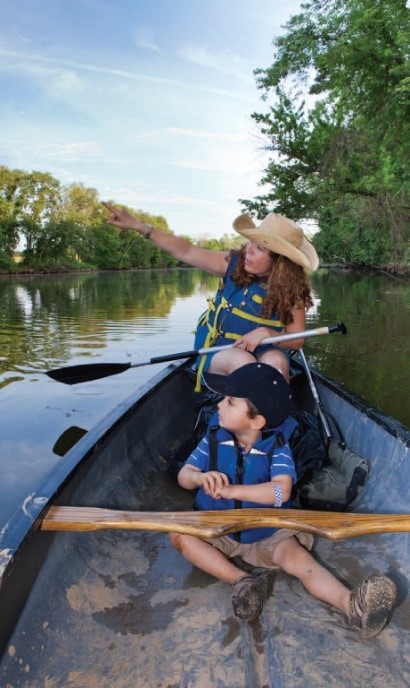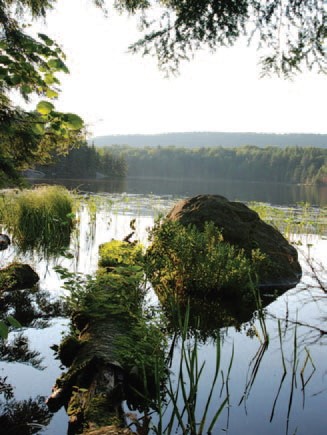Nine Ways to Love Your Lake
 Bodies of fresh water larger than ponds, lakes are vitally important features of the landscape. They typically support a diverse array of birds, animals, fish and flora. They are also important sources of drinking water and water for irrigation and hydropower, and they reduce the frequency and severity of floods. In addition, they provide important recreational opportunities.
Bodies of fresh water larger than ponds, lakes are vitally important features of the landscape. They typically support a diverse array of birds, animals, fish and flora. They are also important sources of drinking water and water for irrigation and hydropower, and they reduce the frequency and severity of floods. In addition, they provide important recreational opportunities.
If you have a lake within your forest or if your property abuts one, protecting it has a direct impact on your health, your trees, the overall value of your property and the enjoyment you derive from the water—as well as the health of all the living things in and around it.
Here Are Nine Ways you Can Show Some Love
1. Watch your wake. Motorboat wakes cause aggressive wave action along shorelines, which, in turn, increases erosion. If your lake is privately owned, create a “no wake” zone 200 feet from the shoreline. This will not only lessen the amount of unwanted sediment in the water but also diminish the disturbance of wildlife, particularly nesting birds and “fish nurseries” along the shoreline.
2. Build a buffer. Having a plant buffer at least 35-feet wide from the high water mark provides shelter to wildlife, filters impurities out of the water and contributes to a more natural view. A shoreline buffer should consist of a mix of native trees, shrubs and ground cover. If you live and recreate at your lake, try to minimize building and other improvements (driveways, decks, etc.) near the shoreline.
3. Go native. Most Tree Farmers already favor native plants and understand the risks of cultivating non-native species. In addition to using native plants, try to limit or eliminate the use of commercial pesticides and fertilizers, which can harm wildlife or contribute to algae growth.
4. Leave fallen trees. When trees fall into the water, they form critical habitat and provide food for insects and tiny aquatic organisms at the bottom of the food chain. They also provide perches for birds and spawning areas for fish. Unless a tree in the water poses a hazard to people or boats, let it be. Your lake will benefit as it decomposes.
 5. Leave large trees. Large canopy trees along the shoreline contribute to the health of a lake in many ways. Their roots stabilize the shoreline. Their leaves create shade over the water, keeping the overall water temperature cooler and more stable. Animals and birds can perch and nest in them, and their debris is part of the aquatic food chain.
5. Leave large trees. Large canopy trees along the shoreline contribute to the health of a lake in many ways. Their roots stabilize the shoreline. Their leaves create shade over the water, keeping the overall water temperature cooler and more stable. Animals and birds can perch and nest in them, and their debris is part of the aquatic food chain.
6. Yank noxious weeds. Eurasian milfoil, fragrant waterlilies, purple loosestrife and yellow flag iris are among the many noxious weeds that commonly invade lakes. These invasive species crowd out native plants, lower oxygen levels in the water and clog boat engines. If you find noxious weeds in your water, eradicate them as soon as possible and always wash your boat, trailer, anchor and anything else that has spent time in another lake before you put it in yours.
7. Leave beavers alone. Beavers can sometimes be vexing, but removing their dams may be illegal in your area, and worse, may cause unwelcome changes to your lake. If a beaver dam negatively impacts your body of water, work with your state conservation department to find ways to address the situation.
8. Manage manure. Human and animal waste is a bane of many lakes. For starters, pick up pet waste to help reduce the chance of fecal contamination. If you have livestock, keep them away from the water. Most important, monitor your septic system. Most systems need to be pumped every three years. Surface water should be diverted away from your leach field and tree roots should not touch drain-field pipes.
9. Use common sense. Before you put anything directly into the water, on the ground or in the air nearby, ask yourself whether it might be unhealthy for the lake. For example, washing your car at your lakefront home or spilling gasoline while fueling your boat at the dock can send unhealthy substances into the water. Fishing with lead tackle and shooting fireworks over the lake may add toxins to the water.
If your Tree Farm reaches the water, it’s naturally contributing to the health of your lake: Wooded areas with a thick understory and a layer of duff absorb water, decreasing runoff and providing a natural filter for contaminants. But that doesn’t mean your lake is pristine. It might look lovely, but unless you are following the nine suggestions above, it probably could use a little more love.










Question maybe someone can answer. I just got appointed co chair lake committee and someone wants to start allowing boats with gasoline engines to fish the lake as long as the engines are not in the water, our lake is electric boats only. It's a 100 acre lake 33 feet deep in middle and averages 15 or lower at shore and primary fill is rain. I say it's a bad idea, can you give me so reasons why I should not allow this?
Thanks
Glenn Beasley